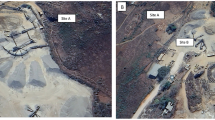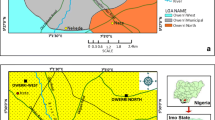Abstract
This study evaluated the scope of exposure to As, Cd, Cu, Fe, Mn, Pb and Zn contents of airborne particulate matter generated from wood processing activities in the Sokoban wood village in Kumasi, Ghana. Samples were collected using 5 µm pore size PVC membrane filter air sampling cassettes placed at workers’ breathing zone. Air was sampled at a 2 ± 0.1 L/min flow rate using SKC Sidekick pumps. Samples were analysed, and data compared with WHO and USEPA recommended levels. Metal levels of wood sellers’ and food vendor’s samples ranged from 0.210 ± 0.145 (Pb) to 10.95 ± 2.37 mg/m3 (Fe) and 0.263 ± 0.352 (Cd) to 10.806 ± 0.263 mg/m3 (Fe) respectively whilst that of furniture manufacturers and machine operators ranged from 0.057 ± 0.095 (Pb) to 11.24 ± 0.028 mg/m3 (Fe) and 0.08 ± 0.08 (Pb) to 12.26 ± 0.365 mg/m3 (Fe) respectively. Investigated metals levels of particulate matter of machine operators, furniture manufacturers, wood sellers and food vendors samples were 20.52 mg/m3 > 19.98 mg/m3 > 17.89 mg/m3 > 17.49 mg/m3 respectively. Workers in direct contact with wood or wood products had high exposure than others. Metals levels were above recommended levels, and workers are at risk of the effects of the investigated metals. Levels of the metals are serious public health issues, and authorities must introduce effective interventions to safeguard health and protect lives.




Similar content being viewed by others
References
Tong S, Tudi M, Ruan HD, Wei B, Wang L, Kong L, Yang LS (2020) Ecological and health risk assessment of trace elements in surface soil in an arid region of Xin Jiang, China. J Soils Sediments 21:936–947. https://doi.org/10.1007/s11368-020-02812-y
Adeoye AO, Adeomi AA, Israel OK, Adewole AO, Temitayo-Oboh AO, Olarewaju SO (2014) Wood dust particles: environmental pollutant in Nigerian sawmill industries. J Environ Occup Sci 3(2):74–80
Doyi INY, Isley FC, Soltani NS, Taylor MP (2019) Human exposure and risk associated with trace element concentrations in indoor dust from Australian homes. Environ Int J 133:1–17
Brauer M, Burnett RT, Pinault LL, Weichenthal S, Crouse DL, Erickson A, Donkelaar AV, Martin RV, Hystad P, Chen H, Fines P, Brook JR, Tjepkema M (2017) Association between fine particulate matter and mortality in the 2001 Canadian Census Health and Environment Cohort. J Environ Res 159:406–415
Nwajei GE, Iwegbue CMA (2007) Trace elements in sawdust particles in the vicinity of sawmill in Sapele, Nigeria. Pak J Biol Sci 10:4311–4314
Adegoke KA, Adesina OO, Okon-Akan OA, Adegoke OR, Olabintan AB, Ajala OA, Olagoke H, Maxakato NW, Bello OS (2022) Sawdust-biomass based materials for sequestration of organic/inorganic pollutants and potential for engineering applications. Curr Res Green Sustain Chem. https://doi.org/10.1016/j.crgsc.2022.100274
Scarabelli TM, Corsetti G, Chen-Scarabelli C, Saravolatz LD (2021) Follicular B-cell lymphoma and particulate matter associated with environmental exposure to wood dust. Am J Case Rep 22:e929396–e929401
Ryabushko VI, Toichkin AM, Kapranov SV (2022) Heavy metals and arsenic in soft tissues of the gastropod Rapana venosa (Valenciennes, 1846) collected on a mollusk farm off Sevastopol (Southwestern Crimea, Black Sea): assessing human health risk and locating regional contamination areas. Bull Environ Contam Toxicol. https://doi.org/10.1007/s00128-021-03451-w
Arun KB, Madhavan A, Sindhu R, Emmanual S, Binod P, Pugazhendhi A, Sirohi R, Reshmy R, Awasthi MK, Gnansounou E, Pandey A (2021) Probiotics and gut microbiome—prospects and challenges in remediating heavy metal toxicity. J Hazard Mater 420:126676. https://doi.org/10.1016/j.jhazmat.2021.126676
de Almeida RP, Ferrari RG, Kato LS, Hauser-Davis RA, Conte-Junior CA (2021) A systematic review on metal dynamics and marine toxicity risk assessment using crustaceans as bioindicators. Biol Trace Element Res. https://doi.org/10.1007/s12011-021-02685-3
USEPA (2007) Method 6200: field portable X-ray fluorescence spectrometry for the determination of elemental concentrations in soil and sediment. Test Methods Eval. Solid Waste US Environ. Prot. Agency. https://doi.org/10.1017/CBO9781107415324.004
Kauppinen T, Vincent R, Liukkonen T, Kauppinen A, Wellin T (2006) Occupational exposures to inhalable wood dust in the member states of the European Union. Ann Occup Hyg 50(6):193–203
WHO (2014) Health risks of heavy metals from long-range transboundary air pollution. Regional Office for Europe of the World Health Organization, Copenhagen
Huang SL, Yin CY, Yap SY (2010) Particle size and metal concentrations of dust from a paint manufacturing plant. J Hazard Mater 174:839–842
Bahattacharya P, Mukherjee AB, Jack G, Nordqvist S (2002) Metal concentration at a wood preservation site: characterization and experimental studies on remediation. Sci Total Environ 290:165–180
IARC (2016) Monographs on the evaluation of carcinogenic risks to humans— wood dust and formaldehyde, vol 62. International Agency for Research on Cancer, Lyon
Scheiber IF, Mercer JF, Dringen R (2014) Metabolism and functions of copper in brain. Prog Neurobiol 116:33–57
Davidson CI, Phalen RF, Soomon PA (2006) Airborne particulate matter and human health: a review. Aerosol Air Qual Res 39:37–749
Gaur P, Mody KH, Jha B (2010) Assessment of heavy metal content in suspended particulate matter of coastal industrial town, Mithapur, Gujarat, India. Atmos Res 97:257–265
Karar K, Gupta AK, Kumar A, Biswas AK (2006) Characterization and identification of the sources of chromium, zinc, lead, nickel, manganese and iron in particulate matter at two sites of Kolkata, India. J Environ Monit Assess 120:347–360
Dahiya S, Karpe R, Hegde AG, Sharma RM (2005) Lead, cadmium and nickel in chocolate and candies from sud-urban areas of Mumbai, India. J Food Compos Anal 18:517–522
Wang Y, Wang S, Wang Y, Lu A, Cao L, Wang J, Gao Z, Yan C (2022) Effects of prenatal exposure to arsenic on neonatal birth size in Wujiang, China. Chemosphere 99:134441. https://doi.org/10.1016/j.chemosphere.2022.134441
Mikkelsen AB, Schlünssen Vivi, Sigsgaard T, Schaumburg I (2002) Determinants of Wood Dust Exposure in the Danish Furniture Industry. Annal Occup Hyg 46(8):673–685
Pisaneillo DL, Cornnell EK, Muriale L (1991) Wood dust exposure during furniture manufacture: results from an Australian-survey and considerations for threshold limit values development. Am Ind Hyg Assoc J 52(11):485–492
Dartey E, Adimado AA, Agyarko K (2009) Evaluation of airborne lead levels in storage battery workshops and some welding environments in Kumasi metropolis in Ghana. J Environ Monit Assess 3(1):271–280
Mugica-Alvarez J, Lopez M, Romero-Romo J, Figueroa-Lara M, Sepulvada-Sanchez T (2012) Concentrations and properties of airborne particles in the Mexico City subway system. Atmos Environ 49:284–293
Abdel Hameed AA, Khoder MI (2000) Evaluation of airborne lead in the welding working environment. J Environ Monit 2:119–121
Hursthouse A, Allen F, Rowley L, Smith FA (2004) A pilot study of personal exposure to respirable and inhalable dust during sanding and sawing of medium density fibre board and soft wood. Int J Environ Health Res 14(4):323–336
Cormier Y, Merlaux A, Duchaine C (2000) Respiratory impact of working in sawmills in Eastern Canada. Arch Environ Health 55(6):424–430
Upadhyay R (2022) Heavy metals in our ecosystem. In: Jitendra K, Shweta G, Prabhat KS, Rohit KM, Sheo MP, Devendra KC (eds) Heavy metals in plants physiological to molecular approach. CRC Press, pp 1–15
Author information
Authors and Affiliations
Corresponding author
Ethics declarations
Conflict of interest
The authors declare that they have no known competing financial interests or personal relationships that could have appeared to influence the work reported in this paper.
Rights and permissions
Springer Nature or its licensor (e.g. a society or other partner) holds exclusive rights to this article under a publishing agreement with the author(s) or other rightsholder(s); author self-archiving of the accepted manuscript version of this article is solely governed by the terms of such publishing agreement and applicable law.
About this article
Cite this article
Dartey, E., Donkor, M.B., Mitchual, S.J. et al. Assessment of Trace Elements in Airborne Particulates at Wood Processing and Marketing Centre in Ghana. Chemistry Africa 6, 1529–1538 (2023). https://doi.org/10.1007/s42250-022-00549-4
Received:
Accepted:
Published:
Issue Date:
DOI: https://doi.org/10.1007/s42250-022-00549-4




